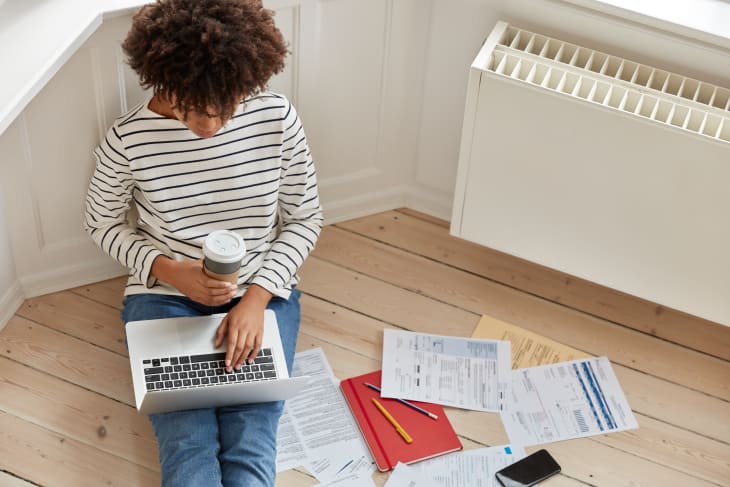Thinking of Putting Less Than 20 Percent Down on a House? Here Are the Pros and Cons

You’ve been pinching pennies and saving like crazy for years, but you’re pretty sure you’re still not even close to saving up a 20 percent down payment — especially in today’s red-hot real estate market. Does this mean you’re completely out of the running when it comes to buying a house? Not at all.
Though 20 percent is a good target to aim for, you can buy a house with a smaller down payment. (Some very specific home buying programs even allow you to buy a house with no down payment!) But, as with anything, there are tradeoffs to putting down 10 or 15 percent instead of 20.
I consulted with mortgage and finance experts to get the scoop on the pros and the cons of making a less-than-20-percent down payment. Here’s what they had to say.
Pros of a Low Down Payment
You’re able to buy a house. Today’s low interest rates (and many other factors) have driven up home prices across the country. This can make it difficult, if not impossible, for some people to save up a 20 percent down payment. Making a smaller down payment may be the only way for you to buy a house and get into the real estate market, period. And that’s OK. Even with a lower down payment, you’re still able to start taking advantage of the perks of homeownership, says Glenn Brunker, president of Ally Home.
“The rise in prices presents challenges for many looking to enter the market and begin building equity,” he says. “High prices require larger down payments, and a traditional 20 percent down payment is often a big hurdle for aspiring homeowners. While 20 percent down is a great goal, borrowers can still enter the market and begin building equity for less.”
You don’t drain your savings. Maybe you can afford to save up the full 20 percent — but you’ll be completely depleting your bank account in the process. This isn’t ideal, since it’s always a good idea to have an emergency fund for unexpected snafus, like getting laid off or needing to pay for major car repairs.
Emergency fund aside, you may need to do some immediate repairs or projects as soon as you move into your new home. Putting down less than 20 percent allows you to hang onto some of your savings for those “just-in-case” expenses.
“Emptying a rainy-day fund leaves new homeowners unprepared for potential home improvement costs that may arise after closing on the home,” Brunker says. “A low down payment helps homeowners get into a home on their timeline — while leaving their savings intact.”
You can invest that money elsewhere. Making a lower down payment gives you the freedom to invest some of your money elsewhere, such as in a retirement account, where you may be able to reap higher returns. Of course, this is all dependent on your unique financial situation, the real estate market in your area, and other factors — if you’re not sure how best to allocate your funds, consider talking with a financial expert who can help you crunch the numbers.
Cons of a Low Down Payment
You have to pay private mortgage insurance. If you put less than 20 percent down, your lender will likely tack on an extra monthly fee called private mortgage insurance, or PMI. This extra charge, which is usually 0.5 to 1 percent of the total loan amount, helps protect the lender in case you default on the loan. It’s added on top of your principal and interest payments, and it doesn’t go toward paying back your loan at all — it’s simply there as a safety net for the lender, explains Elizabeth Root, director of purchase at Better Mortgage.
You don’t have to pay PMI forever, so that’s good news. It goes away once your loan-to-value ratio reaches a certain point, typically 78 to 80 percent. This can happen through you making enough principal payments, refinancing, or getting a new appraisal that shows the value of your home has increased.
You have to take out a bigger mortgage. The smaller the down payment, the larger your mortgage needs to be to cover the cost of the house. Not only does this mean you owe more in principal, but you’ll also pay more in interest over the life of the loan because of the higher amount.
This is less of a big deal if you plan on refinancing or selling your house relatively soon — most people don’t actually stay in their home for 30 years, after all — and, depending on your situation, you may be able to write off some or all of your mortgage interest on your taxes, but it’s still something to consider.
You may get a higher interest rate. PMI aside, your lender may charge you a higher interest rate when you make a smaller down payment. This isn’t a sure thing, and it depends on your unique financial circumstances and the market as a whole, but it’s a pretty likely scenario. Over the life of your loan, a higher interest rate can really add up.
“Prevailing wisdom says it’s best to lower mortgage interest whenever a borrower can,” Brunker says.